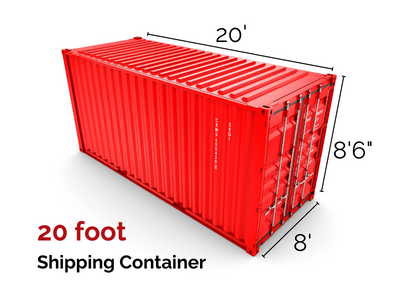Shipping household goods can be a stressful part of the relocation for your employees so an understanding the support you are offering them and setting clear expectations from the start can significantly improve the relocation experience.
In this post, we explore the essential elements of creating effective shipping policies for employee relocation packages.
Photo by cottonbro studio from Pexels
Understanding the Importance of Shipping Policies in Employee Relocation
Shipping policies play a crucial role in employee relocation packages. They provide guidelines and instructions for managers and employees on how to manage the packing and shipment of household effects and personal belongings.
A well-defined shipping policy helps to manage expectations and reduce potential disputes or misunderstandings between employers and employees. It provides a clear framework for what is included in the relocation package and what is not, setting the stage for a smooth and successful relocation process.
Furthermore, shipping policies demonstrate the employer's commitment to supporting employees during the relocation process. By providing clear guidelines and support, employers can help to alleviate some of the stress and uncertainty that often comes with relocating to a new country or city.
DO I need a formal employee shipping policy?
Typically, household goods shipping is provided for employees who are going on long term or permanent assignment.
Whilst technically it's not essential to create a formal policy (you can agree terms and arrangements on a case by case basis if that suits you best) if you are regularly providing shipping benefits to employees then a formal employee shipping policy means:
- Improved employee relocation experience.
- Fairness in the application of relocation benefits (especially from a DE&I perspective).
- Improved time efficiency by reducing approvals on a case-by-case basis.
- Improved cost control and predictability by minimising inconsistent approvals by different managers.
Key Components of an Effective employee relocation Shipping Policy
An effective shipping policy for employee relocation packages should explain:
- Who is entitled to support
- What is included
- The procedure for international personal effects shipping
A typical policy will include several key components such as:
- Clear instructions on the process and the employee's responsibility regarding arranging and preparing for shipment.
- Guidelines on allowances (size and weight limitations)
- Inclusions and exclusions of the policy
- Information on customs regulations and import/export restrictions
- Details on insurance coverage for shipments
- Information on which external parties will be involved in the process, what support they provide and how they will work with the relocating employee.
By including these key components, you can ensure that employees have all the information they need to successfully ship their belongings during their relocation.
What shipping services should we allow for in our shipping policy
Your shipping benefit should provide a professional international removal company (or domestic mover for in-country relocations) to:
- Pack and wrap household goods and personal effects
- Transport door-to-door
- Unpack household goods
- Assist with documentation and customs clearance
- Comprehensive insurance cover
Additional services you might also consider including and should confirm or exclude in your policy include:
- Crating of high-value / fragile items
- Handyman or other professional services (e.g., to dismantle complex furniture, take down / rehang pictures and curtains / disconnect electrical items etc.)
- Pet shipping
- Long or short term storage
-1.jpg?width=600&height=533&name=crate%20up%20stairs%20(crop)-1.jpg)
Employee Shipment Allowances
When developing a shipping policy for employee relocation packages, it is important to consider the allowances for employee shipments. This includes determining the maximum size of the shipment (volume/weight) and sometimes also the value of items that can be shipped. Your allowances should also confirm any restrictions on certain types of items.
Shipment Size Allowances
Shipping allowances can be provided by volume/weight OR container size.
Typically, road shipments are based on a volume (although in some regions like North America they are often weight based), whereas sea shipments are based on a container size and air shipments on weight or volume.
Shipment Value Allowances
Some companies also choose to specify a value allowance (value of goods not costs of shipping). This is an important consideration because it will affect the cost of insuring a shipment. For example, if the insurance premium is 3% of the declared value of goods, then a £50,000 value shipment would incur a cost of £1,500 but a £150,000 shipment would add another £3,000. Some companies may ask that employees cover additional premiums over a certain value if they have an insurance value above the typical employee.
How do I determine shipping allowances?
Allowances are typically set for different family sizes – single employee or single + accompanying partner with additional allowance for any dependent children. Sometimes companies also consider the assignment type, length or employee seniority when determining allowances (see section below on Tiered Allowances).
If you have historical data you can use this to determine the average volumes moved for each family size/assignment type. You should also discuss with your shipping company who can recommend the best breakpoints that will be most cost-effective at the same time as meeting employee requirements. If you do not have historic volumes the Shipping company may be able to advise you based on their own benchmarking data.
Tiered allowances:
When writing your Shipping Policy consider if you need to vary allowances by type of employees or assignment. Does a particular employee population typically have larger homes or higher-value belongings? Do you need to provide better incentives for certain roles to meet their expectations? For example, some companies provide a full shipping allowance for the majority of their employees but offer excess baggage only for graduates who may not yet have accumulated many household goods.
Typical shipping allowances for relocating employees:
- Air: Typically, a single employee may be offered up to 500lbs / 76 cubic feet (net) in air freight, with additional smaller increments for any accompanying partner or dependent.
- Sea: Traditionally most Sea shipments have been broken into two categories – 20ft containers (typically for single person/couple) or 40ft / 40ft high cube containers (family). However, more recently many companies are moving toward a volumetric allowance to reduce wastage having experienced a range in shipment sizes. A volumetric allowance allows the shipping company to recommend the most efficient method of transport, for example utilising shared container services for smaller shipments.
- Road: Road Removal allowances are best expressed as a volume as removal vehicle sizes don’t tend to be equal to a container size, although many companies still use container sizes for allowances for consistency.

We would advise against expressing allowance for shipping as a monetary value due to significant variability in costs based on location, seasonality, volatile shipping line freight fluctuations and individual circumstances like property access. This can lead to inequitable provision and cause headaches for global mobility teams who may frequently be asked to make exceptions or review figures.
Instead, to address cost predictability for business leaders and finance teams, we recommend establishing a framework for cost estimates that accounts for these fluctuations. For example, this can be achieved using historical data, industry benchmarks and predictive analysis to create more accurate initial cost estimates which should periodically be reviewed against actuals.
Inclusions/exclusions:
Your shipping benefit should include all standard costs that come with a household goods shipment that the employee is unlikely to be able to avoid.
Talk to your shipping company (or potential employee relocation companies if you’ve not appointed one yet) about what items they recommend you include/exclude based on your assignee demographics.
Tip: Review your historic exception requests for items that you should consider including / excluding as standard
We’ve seen some policies that have initially excluded items only to find they are frequently requested and approved and have advised clients to include them as standard to avoid un-necessary “noise” for the global mobility team. We may also recommend other items are excluded if they don’t travel well through changing humidity and could lead to higher claims and complaints.
Common Policy Inclusions
- Packing and loading.
- Crating of high value/fragile items where advised.
- Door to door transportation.
- Shipping documentation and related fees.
- Normal customs and import duties.
- Unpacking and removal of debris.
- Insurance.
- Cost of outside elevator or shuttle vehicle if required due to restricted access.
- Parking permits or associated fees.
Common Policy Exclusions
- Duties and taxes applicable for items that may not be eligible, These are usually listed in the customs guide for individual countries, or you can ask your shipping provider to provide a list of the most common items that are not eligible for duty free import. (for example many countries only allow duty free entry of household goods that have been owned for a certain period of time and are not brand new).
- Weekend collection/delivery
- Shipment of excessively heavy/awkward items that may require specialist handling e.g., snooker tables or pianos.
- Machinery or tools.
- Restricted or prohibited items such as tobacco and alcohol, firewood, timber, plants, building material.
- Some high value items such as antique works of art (without prior approval).
- Jewellery, currency, securities and legal documents.
- Delivery/collection from additional addresses
- Third party costs such as electrician/plumber/handyman/cleaners
Pet Shipping Allowances
Historically most companies have not covered international pet relocation, however it is becoming increasingly popular. Pets are a big part of the family for many employees and to offer an attractive relocation package you may want to consider including them (in fact, this has become quite a contentious issue for some of our clients whose employees without children consider their pets to be just like children and feel that if a company provides an allowance for a child, they should also offer allowance for pets).
Pet shipping allowances can be provided as a monetary amount, e.g., up to £1000 per pet with a limit of number of pets, OR an unrestricted coverage for eligible pets. Be careful when it comes to determining eligibility – what you consider to be a pet may not be the same as all employees so it’s important to set this out clearly (for example, most companies do not include non-household pets such as horses which can be considerably more expensive to transport).

Storage Allowances
Short term Storage in Transit
Storage in transit (SIT) refers to the temporary storage of household goods during a relocation. It is a service provided by moving companies to store items in a secure facility while the final destination or delivery arrangements are being finalised - for example while an employee secures a rental property or if they need to vacate their current home before the shipment can depart.
The typical allowance for storage in transit is 30 days in the origin country, and 30 days at destination.
Long Term Storage
Long-term storage in the home country may be necessary for internationally relocating employees for a variety of reasons, for example some employees may be leaving some items behind for non-permanent assignments and want to keep their belongings safe and secure until they return. Additionally, employees may require storage above and beyond SIT if they are in the process of selling their home and need a temporary solution for their belongings ahead of shipping. Whatever the reason, providing the option for long term storage in the home country can offer peace of mind and flexibility for employees during the relocation process.
The typical allowance for long term storage in the home country is up to 1 year, with employees responsible for their own costs after that.

'Cashing out' Shipping Provisions
Historically some companies have allowed employees to 'cash out' their shipping allowances to make their own shipping arrangements. Whilst this gives the employee the flexibility of choosing their own providers and services this method can create risk. The temptation for employees is often to do the move as cheaply as possible which can result in a bad experience, especially when it comes to inexperienced expats who are not experts in international relocation and don't know the important things to look for. (We dive into this topic in a little more detail in our blog about Lump Sum shipping policies if you'd like to know more).
There have also been conversations in recent years regarding environmental sustainability in relation to shipping services - is it more environmentally friendly to 'cash out' shipping provisions and buy or rent furniture in the new country? The comparison is a complex one, taking into account waste and manufacturing impact vs the carbon footprint of transportation and must also be balanced out with the value of shipping familiar things on a smooth transition for the employee and their family. The jury is still out on this one!
Developing an Employee-Centric Shipping Policy
A one-size-fits-all approach may not always be the most effective solution when it comes to developing a shipping policy. Each relocation scenario presents its own set of challenges and considerations. It is essential to understand that employees come from diverse backgrounds with varying needs and circumstances and your policy is an opportunity to provide targeted support to address the unique needs of your diverse workforce.
Whilst policies are designed to be fair and consistent to all, individual circumstances surrounding a relocation will often be different and you may need to be flexible to review individual relocations on a case-by-case basis, albeit in line with your shipping policy.
This means being flexible and adaptable, willing to make exceptions or adjustments where necessary to ensure a smooth and stress-free relocation experience for everyone involved. This may include accommodating special items for VIPs, providing targeted assistance for diverse employees or providing additional allowances for unique situations. The key is to balance the application of policy and control of cost with business goals and the well-being and satisfaction of your employees throughout the shipping process.
It’s also a good idea to review where you have needed to be flexible periodically to see if you need to make any amendments to your policy. If something is coming up frequently then it may be a good idea to update your policy to reduce the admin time for ad hoc review.
Communication and Transparency with Employees
Effective communication and transparency are key when it comes to shipping policies in employee relocation packages. It is important to clearly communicate the shipping policy to employees, including any updates or changes that may occur. Ensure information is available in multiple languages and formats to cater to diverse employee needs.
Your chosen shipping vendor should be fully aware of your policy so that they can set expectations and ensure the services they are providing are aligned.
Additionally, it is important to be transparent about any costs or fees associated with shipping items that they may be personally responsible for. This can help employees to plan and budget accordingly.
.jpg?width=640&height=427&name=pexels-cedric-fauntleroy-8154233%20(1).jpg) Photo by Cedric Fauntleroy
Photo by Cedric Fauntleroy
Evaluating and Optimizing Your Shipping Policy
Once you have implemented a shipping policy for employee relocation packages, it is important to regularly evaluate and optimize the policy to ensure its effectiveness. This can involve gathering feedback from employees who have gone through the relocation process, monitoring the performance of shipping providers, and staying up to date with any changes in transportation regulations or customs requirements.
You should periodically:
- Check your allowances are still in line with employee requirements.
- Update any inclusions/exclusions that are regularly causing you to manage exceptions.
- Review with your shipping service providers if there is anything you adjust in your policy to reduce any “noise” that is consistently reaching global mobility teams.
By continuously evaluating and optimizing your shipping policy, you can ensure that it remains aligned with the needs and preferences of your employees and provides a positive relocation experience.
Need more help?
At Bournes Relocation Solutions we help thousands of families relocate every year and we’d be happy to meet with you to give you a few quick pointers for your policy or guide you through a full review.












